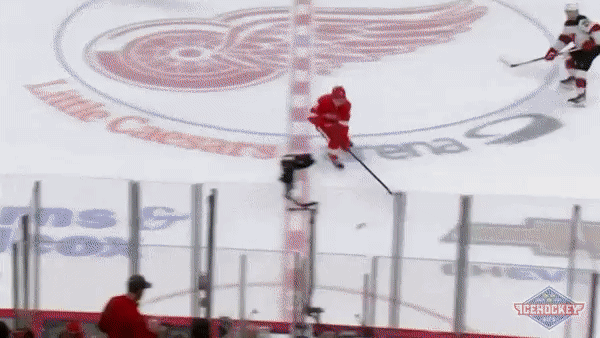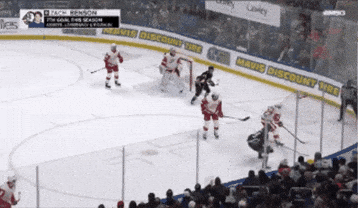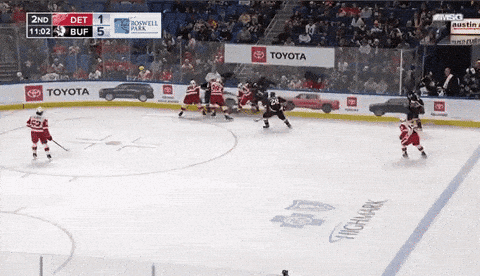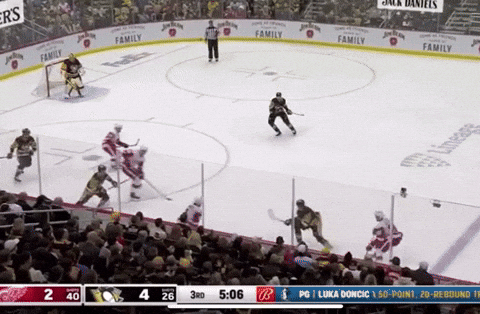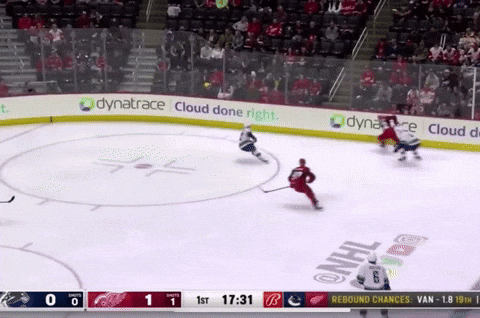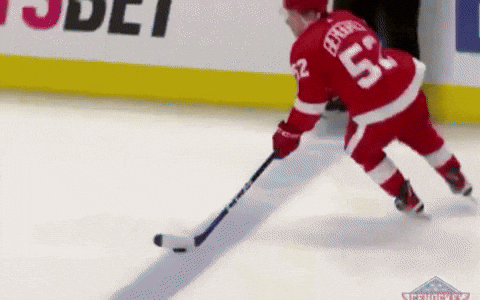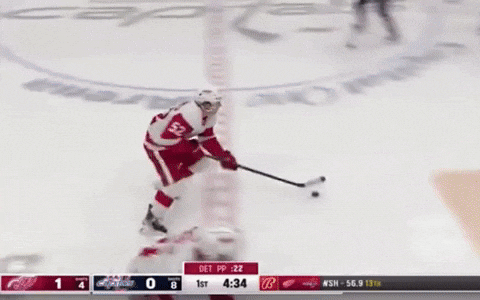Every once in a while we like to highlight players that we find interesting.
Sometimes, it’s for bad reasons, but usually, it’s for good reasons, like in the cases of Seasmus Casey, William Eklund, Emil Andrae, and Macklin Celebrini. A unique player that has caught our eye is current Detroit Red Wings forward Jonatan Berggren.
He doesn’t give off the immediate impression that he is a great player, and he almost seems slightly sloppy. As you look closer, you start to see an imperfect player who finds ways to drive play for his team and produces at a high level.
At 22, Jonatan Berggren broke out for 28 points in 67 games as a bright spot on a Red Wings team largely bereft of scoring.
At 23, he found himself mired in the AHL, with habits away from the puck outweighing his offensive gifts in the estimation of Detroit’s coaching staff.
Now 24, Berggren is playing his best hockey yet, adding 200-foot reliability to what has always been a unique font of offensive talent.
“I think Bergy is playing at a really high level right now,” then Head Coach Derek Lalonde said Oct. 23, 2024 at which point Berggren had just a single assist. “I think he’s driving some lines. Even some of our underlying numbers, he’s leading our team in chances produced, leading in chance differential, which is a positive. So that’s him creating, but it’s him not giving up [offense] too. We’ve been really happy with Jonatan and his commitment to play all 200 feet and still produce some offense.”
Let’s start with the season-by-season journey with words from the Red Wings coaches. We will end with technical skills and tactical habits that raise our antennas. There are more words to start with more video on the backend.
So Why Couldn’t Berggren Taken Off in ‘23-24?
In the 2022-23 season Berggren produced 28 points in 67 games. He found himself spending majority of the 2023-24 season in the AHL with the Grand Rapids Griffins.
“[Austin Czarnik has] given us reliable minutes,” coach Derek Lalonde eventually explained of the decision to have Berggren in the AHL vs in the NHL with the Red Wings.
“And I talk about his (Czarnik) team game of late, how we’re limiting chances, how we look a little less chaotic throughout our entire lineup. I think he’s helped that with just giving us quality minutes down the middle.”
There can be no doubt which player offered Detroit more upside and offense, but Coach Lalonde preferred Czarnik to Berggren in a playoff chase because of his “reliability.”
The biggest area where Berggren struggled to deliver the reliability the Red Wings sought was along the wall on the breakout. Safely exiting the defensive zone was a repeated issue for Berggren, manifesting in two goals against in a 7-3 Detroit loss in Buffalo.
Twice, the puck came to Berggren along the wall, but instead of getting the puck out of the Red Wing zone, he turned it over and watched as the Sabres scored:
One game earlier, the first Detroit goal against came from an odd-man rush sprung by Berggren's turnover, attempting to complete a pass into the slot after gaining the zone that instead launched a Vegas counterattack resulting in a goal against. The turnover was one offense; while being the last man back defensively was a second.
Berggren’s offensive gifts remained evident, but it became clear that he did not have the coach’s trust to make the plays the coach deemed necessary to his team’s playoff pursuit. Berggren had to return to the AHL.
Sticking in the NHL in ‘24-25
Berggren’s board play improvement has been evident. He’s been less turnover-prone and is winning more pucks and retaining possession than in either of his previous two NHL seasons.
“We watch back, and we go through these [games] so in-depth, but I don’t remember a sloppy, loose wall turnover, which was a bad habit of his consistently in the past. Again, a sign of his growth.”
“That’s something I worked on a lot with the coaches, to win more battles,” Berggren told Hockey’s Arsenal. “On the defensive side, when the puck is around the blue line, just chip it out sometimes and win every 50-50 battle there, so I’m feeling I’ve been pretty solid with that.”
By doing what his coaches asked of him, he’s been awarded further opportunities to showcase his game. Between his underlying numbers and rounded-out 200-foot game, there is little doubt that the offensive toolkit that has always defined his game will shine through sooner rather than later.
Technical Skills
At first, you may think he doesn’t look particularly fluid in his skating or puckhandling. Yet as you look closer, you find a player with more than capable technical ability.
Skating
While it can look a little sloppy at first glance, his foundation is rock solid… clean footwork and the ability to quickly change direction.
What makes Berggren truly elite is the separation of his upper/lower body. His lower body is moving him along while his upper body is contorted to meet the requirements of the game.
Stickhandling
He is adept at passing equally well on his backhand as on his forehand. Opponents can’t shepherd him harmlessly in one direction.
He doesn’t do any tricky moves but has the speed of hand to be elusive. He also consistently taps the puck to easily navigate traffic and contact from opponents.
Effortlessly is able to take pucks off the wall and bring them inside to dangerous areas.
Heads-up Awareness
With puck competency, players like Berggren are able to keep their heads up 24/7 to survey the ice.
His body orientation is excellent and allows him to take in tons of information.
Tactical Skills
These technical skills lead to Berggren’s elite tactical game:
Excellent timing
Great space utilization and creation
Berggren understands valuable ice and space. Therefore you’re unable to simply occupy that space and wait for the puck. An element of timing to arrive in that space at the right time is required. It’s about knowing when to attack high-danger spaces and when not to.
Perimeter Player?
Particularly during his draft season, the biggest knock talent evaluators had against his game was that he was what is deemed a “perimeter player.”
Traditionally this is a knock against a player who doesn’t go to the “dirty areas” and stays on the outside of the rink near the wall, often with the play dying out there.
Yet, player location and puck location are not the same things. Noticing where the puck ends up is more important than where the player ends up. It can be easy to watch a player who spends a lot of time with the puck on the outside and then think “he’s ineffective out there” or “That’s not where goals are scored.”
Is Player X making plays from the outside in, or is the play dying out there? One is effective. The other is not.
Finding Soft Spots
1) High Ice
Watch how Berggren works high ice to find open space. Eventually times out the play and works down the middle to find an open passing lane to receive the puck. At first he finds a direct chance from his defenseman passing to him.
Later on in the sequence, he times out the middle route to find an open lane to catch and shoot for the goal.
Here is another example. Rather than chucking a point shot to the net, the defenseman does a soft pass into Berggren. He attacks downhill and buries a beautiful goal in the left-hander’s cheat code spot.

2) Using the Net
Berggren understands that goals are scored at the net.
“I try to be around the net. Good things happen usually when you are there.”
Like many great players, Berggren works well off the net. He understands that it is an awkward spot for the opposition to guard. He positions himself off the back post for a quick reception and pass.
Berggren works off the back post, first as a low support/rim option. He stays attached to the play and takes a step above the goal line. The puck is bouncing around and “with luck” finds him. But truly, Berggren manufactured his own luck.
I particularly love this clip. Berggren comes down the wall and continues behind the net. He asks the question of the defender… are you going to stay with me to leave the middle of the ice? The defender does and the result is a simple tap into the net for a goal.
Connected Skills
Berggren is rarely slowing down to become an easier target to defend. He showcases great usage of edges and skating to maintain speed with clean and effective footwork.
Another key to playing hockey is a separation of upper and lower body. To oversimplify, lower body is for movement while upper body is for playing the game. Berggren rotates well where he can open up his upper body to the middle of the rink. This allows him to be deceptive and quick with his playmaking.
Love this carry and pass. Watch how he continues his route toward the net. His first read is that he needs to offer near-side support but that quickly changes to the other side of the net.
He is already one step ahead and gets there early. He grabs a puck and moves his feet. That opens the passing lane for a back door tap-in.
We won’t get mixtape of his current season until after the season concludes, but enjoy his rookie season and notice the awesome patterns he plays with.
He’s still young and developing, but Berggren seems to have everything he needs to be an NHLer for a long time. Next time you are watching Detroit, take notice of the Berggren and the details we can all appreciate and learn from.
Further Reading

